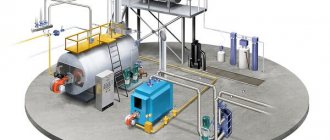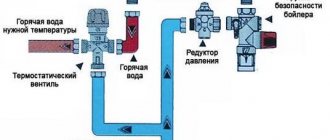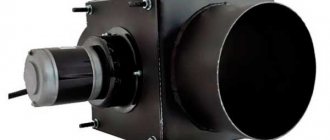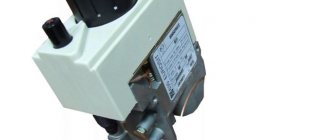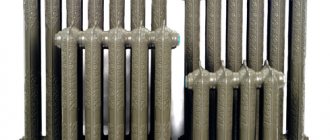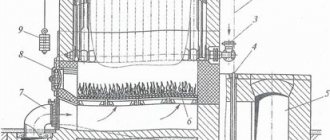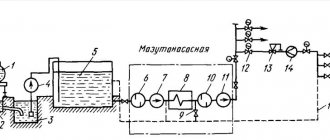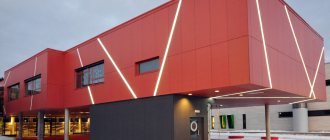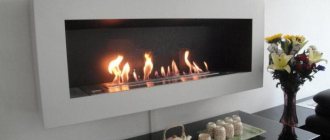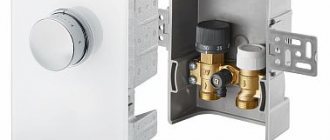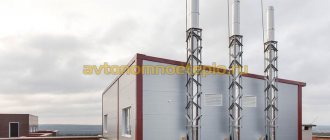Home / Boiler rooms
Back
Published: 10/22/2019
Reading time: 3 min
0
6611
A boiler room is a complex engineering system consisting of a large number of mechanisms and components designed to generate thermal energy for industrial needs and heat supply to residential and public buildings.
The boiler room at the enterprise, as a source of heat, is closely connected with utility networks located both on its territory and outside.
- 1 Types of industrial boiler plants
- 2 Operating principle
- 3 Boiler equipment
- 4 Smoke exhaust systems
- 5 Requirements for industrial gas boiler houses
Types of industrial boiler plants
Industrial gas boilers are classified according to power into low, medium and high power units. The first group includes water heating, steam and condensing generators with a power of up to 20 MW and an efficiency of up to 96%. They are usually used for heat supply to small enterprises.
For integrated heat supply with the delivery of heating, hot water supply and ventilation loads, enterprises install boiler houses with a total capacity of up to 100 MW.
Such equipment is installed in large district boiler houses, capable of providing heat not only to industrial, but also to residential consumers. To supply hot water and steam to large factories and regional city heating network enterprises, gas boilers with a capacity of 600 MW or more are used.
According to their purpose, gas boiler houses at the enterprise are divided into:
- Heating – for centralized supply for the needs of heating, ventilation and hot water supply for domestic and industrial consumers;
- Industrial – for technological supply of heat in the form of steam and hot water to industrial enterprises.
- Heating and production – for integrated heat supply to heating systems and technological processes.
- According to the scheme, boiler houses are divided into a closed type, when all network water through the main heating networks returns back to the source, and an open system, when part of the hot coolant is consumed for technological or domestic needs.
- In industry, technological consumers of thermal energy in the form of steam are paper, chemical and metallurgical production, petrochemical complexes, rectification and chemical reactors, sorption-desorption units for the gas purification process, galvanic lines and devices for laminating surfaces.
A promising direction has become the installation of combined boiler rooms, steam-hydrogen boiler rooms, autonomous block modules, and rooftop heat supply systems.
Good mobile systems are considered to be block-modular, assembled at the factory and transported to the installation site in assembled form.
On-site launch of such systems takes place according to an accelerated turnkey program, taking into account that installation and commissioning work is carried out in production.
How does a gas boiler work?
The first thing you need to understand is what main components the equipment consists of. This will not only help you understand the causes of problems during operation, but will also help you make the right choice when purchasing.
Burner
The main element of a gas boiler. It is a rectangular surface with installed nozzles. Modern manufacturers build in a simulated option: such a burner is capable of consuming only the required amount of gas at different stages of operation, saving up to 15% of fuel. So, during ignition, the gas supply is reduced so that the heat exchanger heats up gradually. Then the fuel supply is gradually increased, approaching and maintaining the set temperature. After heating, the gas supply decreases again. This not only saves “blue” fuel, but also has a positive effect on the service life of the device.
The fuel supply is controlled by a gas valve, which is controlled by a built-in electric motor. This device allows the user to independently set the desired temperature using an electronic board and control panel.
Burners are atmospheric and turbocharged:
- Atmospheric ones are installed near the chimney and take air from the room. Such burners are independent of electricity and are often installed in floor-standing models.
- Turbocharged ones do not depend on the draft in the chimney, because the fan is responsible for the operation, which removes all combustion products. It requires electricity to operate, so it is most often found in wall-mounted boilers.
The burner also contains an ignition electrode (produces a spark that ignites the gas) and a flame control sensor (if the flame goes out for some reason, the automation will shut off the fuel supply and notify of an error).
Heat exchanger
A box with tubes between which there are plates (or “ribs” to increase the usable area and the rate of heating of water). It is through these tubes that water circulates, taking heat from the heated walls.
Heat exchangers are made of different alloys, on which their service life depends:
- Aluminum. The lightest metal, so boilers with such a heat exchanger have compact dimensions. Subject to corrosion; during operation, sediment forms, which reduces the effective heat exchange area.
- Copper. Small weight and dimensions, with good heat dissipation. They are compact and resistant to corrosion, but wear out faster than cast iron.
- Steel. A simple and cheap option. Low thermal conductivity and short service life. Such heat exchangers can become deformed or crack due to temperature changes.
- Cast iron. Durable, reliable, resistant to corrosion, but sensitive to temperature changes. They conduct heat well, but are large and heavy, so they are usually used in expensive floor-standing boilers.
If the boiler is double-circuit, then two heat exchangers are provided: primary and secondary . The main one is installed above the burner; it is used in heating systems. The second is necessary for instant heating of water when the water tap is opened. Such a heat exchanger looks like a set of plates between which water circulates. As soon as the hot water tap opens, all the water from the primary circuit is directed to the second. This is why double-circuit boilers cannot simultaneously heat and heat water. With small volumes of hot water consumption, this is not noticeable; the batteries simply do not have time to cool down.
However, if the water consumption is commensurate with the heating needs, then a bithermal heat exchanger . This is a “pipe in a pipe” that is located directly above the burner. By heating only one heat exchanger, such a boiler can simultaneously provide the house with both heating and hot water. But it is worth remembering: in this case, scale forms very quickly, which must be removed in a timely manner.
Circular pump
Older heating systems used natural circulation of water. The coolant expands when heated, so the water leaving the boiler has low density and weight. Due to this, it easily rises along the hot riser up into the expansion tank, and then spreads downhill over the radiators and gives off heat. As it cools, the density and weight of the water increase, so it flows downhill again into the boiler.
Despite its simplicity, reliability, energy independence and quiet operation, such a system has serious disadvantages: complex and expensive installation, water freezing, air entering the heating system, low temperature of radiators in far corners.
Therefore, modern boilers are equipped with a special circular pump, which creates pressure for constant circulation of water. Yes, in this case, independence from electricity disappears, but the batteries will always be warm.
Expansion tank
When heated, water expands, so it is necessary to maintain a balance in the heating system. This is why an expansion tank is used, consisting of 3 parts:
- container for excess water;
- membrane;
- container with nitrogen.
The principle of operation is simple: excess water is stored in a tank, and the membrane balances the pressure change in the heating system.
Smoke removal
Any gas boiler necessarily requires removal of combustion products. If the combustion chamber is open, then air from the room is used for operation, so good ventilation is needed here and a chimney is equipped.
If the boiler has a closed combustion chamber, then air from the street is used (using a fan) and heated by combustion products. Such devices do not require additional ventilation.
Safety automation, electronics and control module
This category includes various sensors for monitoring ongoing processes in the operation of the boiler and monitoring the condition of the heating system. The safety system allows you to protect the unit from lack of draft, overheating or lack of flame in the burner. In these cases, the sensors report a malfunction and the control module stops boiler operation.
Principle of operation
Gas industrial boiler houses, regardless of their power, practically have the same control scheme and operating principle. Structural differences are observed only in water-water and steam-water boilers. Boiler installations of industrial enterprises consist of main and auxiliary equipment.
The main ones include the boiler itself and the devices enclosed in its body - pipe packages, separators, manifolds, drums. Auxiliary equipment includes a gas burner, pumps, fans, smoke exhausters, fittings, fittings, and an automatic control and safety system.
In hot water boilers, water is heated to a maximum temperature of 150 C as a result of fuel combustion and heat transfer from flue gases to the main coolant. The panels are made gas-tight to increase heat transfer; for this purpose, steel pipes are welded together.
After combustion, the flue gases of the water, under the influence of the vacuum created by the smoke exhauster, enter the convector block, where the pipes are mounted in a checkerboard pattern, which increases the heating surface and the rate of transfer of water to the network coolant.
In a hot water boiler, water moves forcibly; the speed of movement is determined by network pumps, which provide the necessary performance and pressure. Water enters and exits through the boiler manifold.
The operating principle of a steam boiler differs from a hot water boiler. The movement of water in its internal circuit occurs due to the natural circulation of cold and heated steam-water media.
As a result of the heat transfer process, saturated or superheated steam is obtained at the boiler outlet. To collect it, modern boilers install drums and separation devices in the upper drum to remove the smallest particles of boiler water from the steam.
Network water does not circulate through the steam boiler; it is fed with chemically purified feed water using special feed pumps. The network water circuit does not intersect with the feed water, and it is heated in steam-water network heat exchangers, in which steam from the boiler through a pipe system heats the supply coolant to a maximum temperature of 150 C.
What is required to operate a boiler room?
Gas boiler houses are the most popular in Russia. This is due to the cheapness and availability of fuel: almost all areas in our country are gasified, except for new and completely remote ones. Everyone in our country is familiar with gas: the most common household stoves use it.
However, in the boiler room the gas pressure is much higher - on average, to heat a residential building, a pressure of up to 5 kPa is used, and for a boiler room - up to 0.3 MPa.
The second important element of a boiler room is water, but the requirements for it are very specific. For the installation to work as it should, a lot of water is required, and it must be very soft. The liquid is purified using filters that are constantly updated, since water passes through them non-stop.
Oxygen is then removed from the filtered water: the boiler cannot work with oxygen-saturated water. To remove it, special deaerator devices are used that “pasteurize” the water, which is then delivered to the boiler.
Naturally, all processes cannot occur in a boiler room independently, under the influence of its own forces. The boiler requires a centrifugal fan to pump in air, a smoke exhauster to remove combustion products, and pumps to pump out water. All kinds of additional equipment helps to monitor the operation of systems, secure the boiler room, and reduce risks. Any modern boiler room, whether autonomous or centralized, also requires a set of emergency devices. And all this consumes electricity.
In addition, any boiler room is equipped with radiators and pipes that make up the heating mains: sometimes the distance from the boiler to the heated object can be very large.
Boiler equipment
Boilers are the main element of the organization and implementation of the steam power cycle of the heat supply system. The body of low-power low-pressure boilers is made of cast iron, and the body of medium and high-pressure boilers is made of boiler steel.
In order to correctly select the type and number of boilers, technical and economic calculations are performed, taking into account the following factors:
- Maximum and minimum heat load of consumers in winter and summer.
- Distance and diameters of heating networks broken down to each consumer.
- Quality of water and fuel.
- Level of automation of a gas boiler room.
- Boiler room dimensions.
The next most important element of the boiler unit is the burner device, where the process of mixing gas and air and igniting the gas-air mixture to form a torch takes place. The combustion process itself takes place in the combustion chamber.
The choice of boiler based on the heat output of the burner must correspond to its power, taking into account the emergency reserve. Good Lemax gas equipment can be purchased in Ishim.
The operation of the burner is ensured by the gas equipment of the boiler room: gas distribution unit or hydraulic fracturing unit, regulators, filters, control devices and a security system. All elements of the gas industry are classified as high-risk objects; their operation is regulated by SNiP II-35-76 “Boiler installations”.
Boiler room auxiliary equipment
In order for heat transfer processes to occur effectively in the boiler, all flows of water, fuel and air must undergo a preparation process before being supplied to the unit. These tasks are performed by auxiliary boiler installations.
Group of pumps in a boiler room
The auxiliary elements of the boiler unit include the following devices:
- fuel supply systems;
- smoke purification systems;
- draft devices;
- feed and circulation pumps responsible for the movement of water along the circuit;
- boiler separation devices;
- water treatment plant.
Draft devices include smoke exhausters and fans operating in the gas-air duct system of the boiler. The former serve to create a vacuum in the combustion chamber and remove flue gases through the chimney into the atmosphere.
They are installed between the flue and the chimney, usually outside the boiler room, at the back of the boiler, due to the high noise level generated during operation.
Fans are designed to force air into the combustion chamber, to create a gas-air mixture at the outlet of the gas burner, to ensure complete combustion of the fuel. The device is also installed outside the boiler house building, but in front of the boiler front.
Separation devices are used to separate steam from boiler water; they are installed in the upper drum of the boiler. The water treatment system purifies feed water from hardness salts in sodium cation exchanger filters to reduce scale formation processes on the boiler heating surfaces of the boiler and removes active oxygen in the deaeration-feeding unit to reduce corrosion processes in the internal heating surfaces of the heat generator.
To power steam boilers, at least two electric pumps are installed, with an operating pressure of at least 1.25 pressure of the boiler water path, and a productivity of 110% of the rated steam output of all operating boilers.
In addition, two steam pumps are installed with at least 50% of the boiler room’s rated output.
Boiler room pumps are divided into:
- Feeding - designed to supply feed water to the boiler.
- Make-up tanks - for recharging the heating circuit in case of coolant leaks in the main networks.
- Network for coolant circulation in the supply and return pipelines. They are also used for hot water boiler houses.
- HVO pumps - in the chemical water treatment system.
- Gas equipment.
Smoke exhaust systems
The boiler room smoke ventilation system is used to create a vacuum in the gas path of the boiler unit and remove flue gases from the boiler into the atmosphere. It consists of a smoke exhauster, a fan, chimneys and a chimney.
Instrumentation and safety automation (ICS) are designed to monitor the operation of the installation according to regime maps, regulate the boiler load and ensure safe operation of the equipment.
In all modern boiler units, the installation of instrumentation and control equipment is a mandatory requirement, in accordance with the norms and regulations for the operation of boiler installations.
Boiler equipment protection is triggered by activating sound and light alarms to alert operating personnel.
Instrumentation and automation protection parameters:
- separation of the torch in the boiler;
- high pressure of steam, gas, water;
- low vacuum in the boiler furnace;
- power outage;
- low water level in the boiler;
- low pressure of air, water and gas.
When the alarm is triggered, after a short time, if the operating personnel have not corrected the failure, the boiler is stopped by the instrumentation and control system, through forced shutdown of the gas supply to the furnace.
Design of TGU 100-200 kW on gaseous fuel
TGUs are small-sized boiler houses of a modular type. The modules are made in the form of block boxes - metal containers with fixed sandwich panels 80 mm thick. Sandwich panels are installed from the outside as wall and roof panels. The color is selected in accordance with the wishes of the Customer.
The modules are equipped with a supply and exhaust ventilation system, which is carried out through easily removable ventilation grilles. Air is supplied in sufficient quantities, ensuring the necessary air exchange in the room and stable operation of gas burners.
Equipment and pipelines are coated with an anti-corrosion compound, which increases their strength and resistance to negative chemical influences. Heating surfaces with temperatures above 45°C are additionally thermally insulated.
Requirements for industrial gas boiler houses
Gas boiler houses are fire hazardous facilities; they are subject to special requirements at the stages of design, installation and operation. The basic requirements are enshrined in SNiP II-35 - “Boiler installations”.
Requirements for pumps are specified in SP 89.13330.2012. Water and steam must comply with GOST 20995-75, 2761-84, and the chemical water treatment system must comply with SNiP 2.04.02-84 “Water Supply”. More detailed information on the requirements and rules can be found in the book “Boiler installations of industrial enterprises” (L.N. Sidelkovsky, V.N. Yurenev).
Industrial boiler boiler boilers are installed in a separate building, whose fire resistance is determined by production requirements. For installation of large-sized elements and components of the boiler, installation openings must be provided.
The design and construction of industrial boiler houses is carried out taking into account existing building plans and utilities in the area of the proposed construction.
The project should include a boiler room, a pump room, a fuel facility, premises for chemical water treatment and instrumentation.
